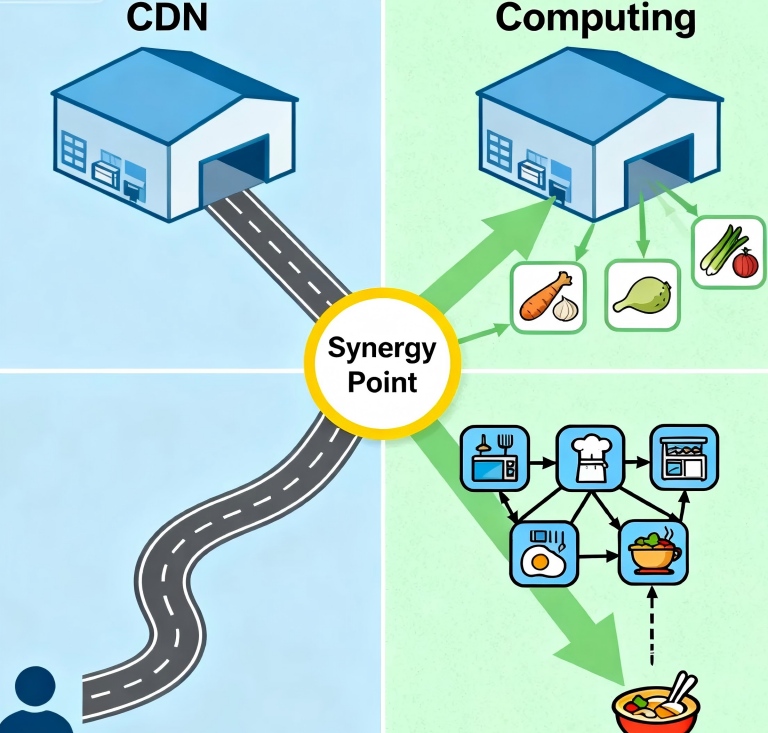
Have you ever heard a new technology buzzword that makes you wonder if everything you’ve learned is suddenly obsolete? Right now, that word for many people is “edge computing.” We’ve been talking for years about how Content Delivery Networks (CDNs) are the king of speed, bringing content closer to the user to reduce latency. It's the simple, elegant solution. But then, edge computing arrives on the scene, promising to move not just content, but computation to the edge. A sudden, confusing thought pops into your head: Is a CDN just a clunky, outdated relic of a bygone era? Has edge computing completely replaced its function?
It’s a natural reaction to the relentless pace of innovation. You might feel like you’re standing at a fork in the road, faced with a choice between an old, trusted path and a new, mysterious one. But here’s the unexpected truth: this is not an either/or situation. It's not a competition. Edge computing isn't here to kill the CDN; it's here to take it to the next level. Think of it less as a replacement and more as a profound evolution. A CDN is the foundation; edge computing is the intelligence built on top of that foundation. It’s the difference between a high-speed road and a high-speed road with smart traffic signals, real-time navigation, and local service stations.
So, let's dive into this apparent conflict and see why a CDN is not only still relevant, but more crucial than ever in the age of edge computing.
The Fundamental Difference: A CDN’s Core Mission
To understand the relationship between these two technologies, you have to get to their core purpose. A CDN's primary mission is to solve a very specific problem: caching and delivering static content at a high velocity. Its job is to take a snapshot of your website’s images, videos, and stylesheets and replicate them on servers all over the world. When a user requests that content, the CDN simply delivers the pre-packaged file from the closest server. It’s about delivery efficiency. It doesn't modify the content; it just gets it from point A to point B as fast as possible. This is the simple, foundational layer of the internet’s performance engine.
This is a vital, non-negotiable function. Over 80% of the data on a typical website is static. It's the heavy lifting that bogs down your origin server and creates a slow user experience. A CDN handles this monumental task with unparalleled efficiency, offloading the majority of your traffic and ensuring that a user in Tokyo gets the same fast experience as a user in Toronto. This is the delivery layer.
The Intelligence Layer: What Edge Computing Does
Now, let's talk about the new kid on the block. Edge computing takes the CDN model and asks a simple question: "What if we could also do things with the data at the edge?"
Edge computing moves computation, application logic, and data processing out of the central cloud and to the edge of the network—right where the data is created and consumed. Instead of sending a raw data feed from an IoT sensor all the way to a central server for analysis, edge computing allows you to run a simple script on a nearby server to process the data and send back only the most relevant information.
This is a profound shift from delivery to computation. A CDN can hand out a static image, but edge computing can process an API request, run a serverless function, or even handle real-time AI inference. It’s the difference between a library that just lends you a book and one that also has a quiet reading room, a cafe, and a research lab all within the same building.
So, while the CDN's job is to get a pre-packaged box from the warehouse to your door, the edge computing layer is the local shop that can open the box, modify its contents based on your unique needs, and then reseal it and hand it to you in milliseconds. It’s about personalization, real-time responsiveness, and intelligent processing.
The Perfect Synergy: Why One Can’t Live Without the Other
This is the most important part of the conversation. The CDN and edge computing are not rivals; they are a symbiotic duo. A high-performance digital presence in today's world requires both.
The CDN provides the global network for the edge to exist. The "edge" of edge computing isn't a single place; it's a global network of PoPs. Where do these PoPs come from? The world’s leading CDNs. Without the CDN's massive, distributed infrastructure, edge computing would have nowhere to run its functions. The CDN built the superhighway; edge computing adds all the intelligent features to that highway.
Edge computing makes the CDN smarter and more dynamic. A CDN on its own is a fantastic tool for static content, but what about dynamic content that changes for every user? Edge computing functions, which can run directly on the CDN's nodes, can handle this. For an e-commerce site, an edge function can instantly personalize a web page based on a user's location or browsing history, without having to make a full round trip to the origin server. This allows the CDN to be more than just a delivery service; it becomes a powerful, dynamic platform.
They work together to create a seamless user experience. The ideal workflow is a perfect marriage of the two. The CDN handles the heavy lifting of caching and delivering all your static content (images, videos, etc.) at lightning speed. Then, for the dynamic content, the edge computing layer intelligently processes the requests at the closest possible point, ensuring that even the most complex applications feel instant and responsive.
This is a sudden, powerful realization. The old model was a simple request-and-response. The new model is an intelligent, distributed conversation. A CDN remains absolutely essential as the physical layer that makes the entire network fast. Edge computing is the software layer that makes it smart. You can't have a truly high-performance digital presence with just one of them. The future is a unified platform where a CDN's network and edge computing's intelligence merge into a single, seamless solution. The question isn't whether a CDN is still relevant; it's whether you're using your CDN's full potential to embrace the edge. The answer is yes, it's more relevant than ever.

